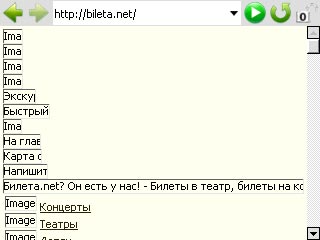Affordable but Inaccessible Mobile Internet
- Cross-post from my blog.
Today, the mobile Internet is no longer a rarity, but a convenient tool. It can be met almost everywhere. In a traffic jam, you can see a neighbor’s laptop in the front seat, in the subway of a student who reads bash.org.ru, and in the park on the bench a girl who is sitting in ICQ.
With all the confidence we can say - today mobile Internet is available as never before. It is available in many ways, in particular - the Internet is where there is provider coverage (another question is quality, but more on that later) and inexpensive.
If you take me as an example, then I do not deny myself anything for two hours a day - forums, blogs, news feeds, bash and IM, up to Skype. In addition to Skype, I use all these benefits in the subway. And I pay for this pleasure a maximum of 250 rubles per month.
However, if you think that the entire network is available to you, then you are not mistakenly mistaken. Let's go through the examples, even show screenshots. The task is simple, find out from some organizations the phone, or address.
What disadvantages can we meet? There are several of them, in my opinion. I will describe those that really interfere with obtaining information. This is the phone or mail indicated in the picture. As a rule, I turn off the pictures in order to speed up the download and save on traffic. Everything would be fine, you say, is alt, which was created specifically for this. However, not all webmasters size images, and alternative text. And if you enter an alternative text, it is completely unobvious, for example: "Phone". For example, the site of a fairly well-known bank, the ATMs of which you saw for sure. I won’t give an active link, otherwise you’ll consider it an advertisement - just a screenshot:

Next comes the well-known office that will “help” us book a ticket, for example, for a concert:

Such examples in Runet are full of complete. The next time you go to a website from your mobile phone - pay attention.
Now let's see how you can organize a version of the site that will be comfortable viewing on the screen of a mobile phone.
I see only two options that deserve consideration. However, among the two options there is an absolute leader. But I will tell about both.
Option number one is styles:
CSS introduced the concept of media type, when the style is applied only to a specific one - for mobile phones it is handheld. For example, the code for connecting styles for a mobile phone will look something like this:
Such styles optimize in a special way. They replace graphics with html + css, hide unnecessary ones, for example, blocks of secondary importance, and somewhat adjust the sizes of blocks. Unfortunately, I am not ready to write a universal manual on optimizing styles for mobile phones. Although the question is interesting, and perhaps I will cover it someday. This method is good because having spent a minimum of effort, you can adapt the page overloaded with graphics and information to a more or less suitable form for viewing it using a mobile device (in the end there are PSP, Palms, etc.). However, I prefer a different method.
Option number two:
You probably know the following pages:



As you can see, these are full-featured (with some exceptions) versions of sites, but in a special, minimized format. Optimized graphics, which weigh a penny and are cached, few styles that, although cached, still generate traffic and a minimal amount of Java Script - this is the key to the success of mobile sites. This method is good for everyone, in fact, it is worth confessing, some time ago I was forced to sit on dialup, and the mobile versions of Yandex and mail.ru saved me weakly (yes, yes - I had a need for mail.ru - please do not rush tomatoes)
As you can see, with the penny cost of mobile Internet, we cannot enjoy all the delights of the Web. And until our mobile phones learn to deploy screens up to 13 inches, we will have to meet with a large number of sites that are openly hostile to us, ordinary users, are set up.
Here is a story from the life of a friend of mine, a courier. He was given the task of delivering a package of documents, the deadlines were running out (express delivery), and he galloped across Europe somewhere off to the outskirts of the city, to an area which was essentially in the midst of construction. Naturally, the guy was lost, but decided to get out of the situation and make a phone call. Indicated on the invoice. It turned out that the number is incorrect. They could not help in the control room, and probably did not want to. Having learned the company’s website through Yandex, he goes there and stumbles upon the site. Which is fully woven from pictures. Text, menu, side blocks - I had to load pictures. Not even money matters, but time - he barely managed to deliver a package of documents by the due date. But it cost nothing to add alternative text to the picture with the phone.
The most annoying thing is that tomorrow you may need to find out not the phone number for work, but the address of the nearest pharmacy or the phone number of the nearest hospital. Naturally, there are alternative sources of this information, but this does not eliminate the unpleasant aftertaste when you come across a site, the first screenshot of which I posted in this article.
Today, the mobile Internet is no longer a rarity, but a convenient tool. It can be met almost everywhere. In a traffic jam, you can see a neighbor’s laptop in the front seat, in the subway of a student who reads bash.org.ru, and in the park on the bench a girl who is sitting in ICQ.
With all the confidence we can say - today mobile Internet is available as never before. It is available in many ways, in particular - the Internet is where there is provider coverage (another question is quality, but more on that later) and inexpensive.
If you take me as an example, then I do not deny myself anything for two hours a day - forums, blogs, news feeds, bash and IM, up to Skype. In addition to Skype, I use all these benefits in the subway. And I pay for this pleasure a maximum of 250 rubles per month.
However, if you think that the entire network is available to you, then you are not mistakenly mistaken. Let's go through the examples, even show screenshots. The task is simple, find out from some organizations the phone, or address.
What disadvantages can we meet? There are several of them, in my opinion. I will describe those that really interfere with obtaining information. This is the phone or mail indicated in the picture. As a rule, I turn off the pictures in order to speed up the download and save on traffic. Everything would be fine, you say, is alt, which was created specifically for this. However, not all webmasters size images, and alternative text. And if you enter an alternative text, it is completely unobvious, for example: "Phone". For example, the site of a fairly well-known bank, the ATMs of which you saw for sure. I won’t give an active link, otherwise you’ll consider it an advertisement - just a screenshot:

Next comes the well-known office that will “help” us book a ticket, for example, for a concert:

Such examples in Runet are full of complete. The next time you go to a website from your mobile phone - pay attention.
Now let's see how you can organize a version of the site that will be comfortable viewing on the screen of a mobile phone.
I see only two options that deserve consideration. However, among the two options there is an absolute leader. But I will tell about both.
Option number one is styles:
CSS introduced the concept of media type, when the style is applied only to a specific one - for mobile phones it is handheld. For example, the code for connecting styles for a mobile phone will look something like this:
Such styles optimize in a special way. They replace graphics with html + css, hide unnecessary ones, for example, blocks of secondary importance, and somewhat adjust the sizes of blocks. Unfortunately, I am not ready to write a universal manual on optimizing styles for mobile phones. Although the question is interesting, and perhaps I will cover it someday. This method is good because having spent a minimum of effort, you can adapt the page overloaded with graphics and information to a more or less suitable form for viewing it using a mobile device (in the end there are PSP, Palms, etc.). However, I prefer a different method.
Option number two:
You probably know the following pages:



As you can see, these are full-featured (with some exceptions) versions of sites, but in a special, minimized format. Optimized graphics, which weigh a penny and are cached, few styles that, although cached, still generate traffic and a minimal amount of Java Script - this is the key to the success of mobile sites. This method is good for everyone, in fact, it is worth confessing, some time ago I was forced to sit on dialup, and the mobile versions of Yandex and mail.ru saved me weakly (yes, yes - I had a need for mail.ru - please do not rush tomatoes)
As you can see, with the penny cost of mobile Internet, we cannot enjoy all the delights of the Web. And until our mobile phones learn to deploy screens up to 13 inches, we will have to meet with a large number of sites that are openly hostile to us, ordinary users, are set up.
Here is a story from the life of a friend of mine, a courier. He was given the task of delivering a package of documents, the deadlines were running out (express delivery), and he galloped across Europe somewhere off to the outskirts of the city, to an area which was essentially in the midst of construction. Naturally, the guy was lost, but decided to get out of the situation and make a phone call. Indicated on the invoice. It turned out that the number is incorrect. They could not help in the control room, and probably did not want to. Having learned the company’s website through Yandex, he goes there and stumbles upon the site. Which is fully woven from pictures. Text, menu, side blocks - I had to load pictures. Not even money matters, but time - he barely managed to deliver a package of documents by the due date. But it cost nothing to add alternative text to the picture with the phone.
The most annoying thing is that tomorrow you may need to find out not the phone number for work, but the address of the nearest pharmacy or the phone number of the nearest hospital. Naturally, there are alternative sources of this information, but this does not eliminate the unpleasant aftertaste when you come across a site, the first screenshot of which I posted in this article.
